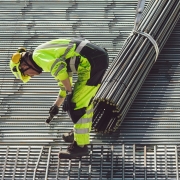The Importance of Steel Toe Caps & Anti Slip Polyurethane Soles
Do Safety Boots Need Steel Toe Caps?
Steel toe caps and anti-slip polyurethane soles are two of the most important features in safety footwear. These features not only provide protection for the wearer but also offer additional safety benefits that are crucial in hazardous environments. In this blog post, we will explore the importance of steel toe caps and anti-slip polyurethane soles in safety footwear and why they are essential for industrial workers, construction workers, and anyone who works in potentially dangerous conditions.
Why Do I Need Steel Toe Caps?
Steel toe caps are a crucial element in safety footwear as they provide protection for the toes from heavy objects, sharp materials, and potential crushing accidents. The steel toe cap is designed to withstand impacts and pressure, preventing serious injuries such as fractures, cuts, and amputations. In high-risk environments such as construction sites, factories, and warehouses, steel toe caps are a necessity to protect workers from potential hazards.
In addition to protecting the toes, steel toe caps also provide stability and support for the feet, reducing the risk of slips, trips, and falls. The rigid structure of the steel toe cap helps to maintain the shape of the shoe and prevents it from collapsing under pressure, keeping the foot secure and stable. This is crucial for workers who are constantly on their feet and moving around in challenging conditions.
Do Safety Boots Need Anti-slip polyurethane Soles?
Anti-slip polyurethane soles are another important feature in safety footwear that enhances the overall safety and performance of the shoe. These soles are designed to provide maximum traction and grip on slippery surfaces, reducing the risk of accidents and injuries caused by slips and falls. The anti-slip properties of polyurethane soles are particularly beneficial in wet or oily environments where the ground may be slick and hazardous.
The durable and flexible nature of polyurethane soles also offers a comfortable and supportive fit for the wearer. These soles are lightweight and shock-absorbing, reducing strain on the feet and legs during long periods of standing or walking. This is especially important for workers who are required to be on their feet for extended periods of time, as it helps to prevent fatigue and discomfort.
Long Lasting Steel Toe Caps
In addition to their protective and safety benefits, steel toe caps and anti-slip polyurethane soles are also highly durable and long-lasting, making them a cost-effective investment for employers and workers alike. Safety footwear with these features is designed to withstand the rigors of daily wear and tear in harsh working conditions, providing reliable protection and performance over an extended period of time.
Overall, steel toe caps and anti-slip polyurethane soles are essential features in safety footwear that offer crucial protection and safety benefits for workers in hazardous environments. These features help to prevent serious injuries, enhance stability and support, provide maximum traction and grip, and offer long-lasting durability and comfort. By investing in safety footwear with steel toe caps and anti-slip polyurethane soles, employers can ensure the well-being and safety of their workers, while workers can perform their duties confidently and securely in challenging conditions.
For a chat about your work forces safety boot requirements please give us a call on +27 11 892 8030 / 8031 / 8032 or drop an email to organise a call info@profitfootwear.co.za.




